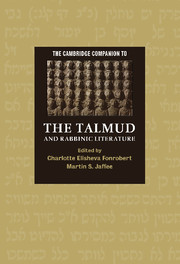Book contents
- Frontmatter
- Introduction: The Talmud, Rabbinic Literature, and Jewish Culture
- Part I: The Conditions of Rabbinic Literary Activity
- Part II: The Genres of Rabbinic Literary Composition
- 5 Rabbinic Midrash and Ancient Jewish Biblical Interpretation
- 6 The Judaean Legal Tradition and the Halakhah of the Mishnah
- 7 Roman Law and Rabbinic Legal Composition
- 8 Middle Persian Culture and Babylonian Sages: Accommodation and Resistance in the Shaping of Rabbinic Legal Tradition
- 9 Jewish Visionary Tradition in Rabbinic Literature
- 10 An Almost Invisible Presence: Multilingual Puns in Rabbinic Literature
- Part III: Hermeneutical Frames for Interpreting Rabbinic Literature
- Bibliography
- Index
- Source Index
- Series List
8 - Middle Persian Culture and Babylonian Sages: Accommodation and Resistance in the Shaping of Rabbinic Legal Tradition
from Part II: - The Genres of Rabbinic Literary Composition
Published online by Cambridge University Press: 28 November 2007
- Frontmatter
- Introduction: The Talmud, Rabbinic Literature, and Jewish Culture
- Part I: The Conditions of Rabbinic Literary Activity
- Part II: The Genres of Rabbinic Literary Composition
- 5 Rabbinic Midrash and Ancient Jewish Biblical Interpretation
- 6 The Judaean Legal Tradition and the Halakhah of the Mishnah
- 7 Roman Law and Rabbinic Legal Composition
- 8 Middle Persian Culture and Babylonian Sages: Accommodation and Resistance in the Shaping of Rabbinic Legal Tradition
- 9 Jewish Visionary Tradition in Rabbinic Literature
- 10 An Almost Invisible Presence: Multilingual Puns in Rabbinic Literature
- Part III: Hermeneutical Frames for Interpreting Rabbinic Literature
- Bibliography
- Index
- Source Index
- Series List
Summary
JEWS AND PERSIANS
Jews and Persians had coexisted in Mesopotamia, mostly peaceably, for some 750 years before the Sasanian dynasty took over from the Arcasids in 224 C.E. They would continue to do so for more than another four centuries, including the entire amoraic period (220-500 C.E.). As the late third-century R. Huna put it, the Babylonian “exiles” were at ease in Babylonia, as the other exiles - those in the Roman world - were not (B. Menahot 110a). The Persian emperor wanted it that way. Jews were a significant minority in a vital province; Mesopotamia was both the breadbasket of the empire and the province most vulnerable to Roman invasion; unlike Christians, who might become a fifth column once Christianity became a tolerated religion in 313 C.E., the Jews would support the regime if they were left alone.
At the same time, the official religion of the Persian Empire, Zoroastrianism, was comfortable and even familiar to the Jews, with its theological doctrines of creation by the benevolent and omniscient Ohrmazd, the fight against evil, reward and punishment, heaven and hell, judgment, creation, the coming of three pivotal “messianic” figures, the ultimate defeat of evil, the resurrection of the dead, and the renewal of creation. This was true of its ethical system as well, with its emphasis on right thought, speech, and action, and its ritual system, with its stress on the avoidance of idolatry, its hatred of sorcery, “wasting of seed,” and contact with menstruant women and dead bodies.
- Type
- Chapter
- Information
- The Cambridge Companion to the Talmud and Rabbinic Literature , pp. 165 - 197Publisher: Cambridge University PressPrint publication year: 2007
- 16
- Cited by

